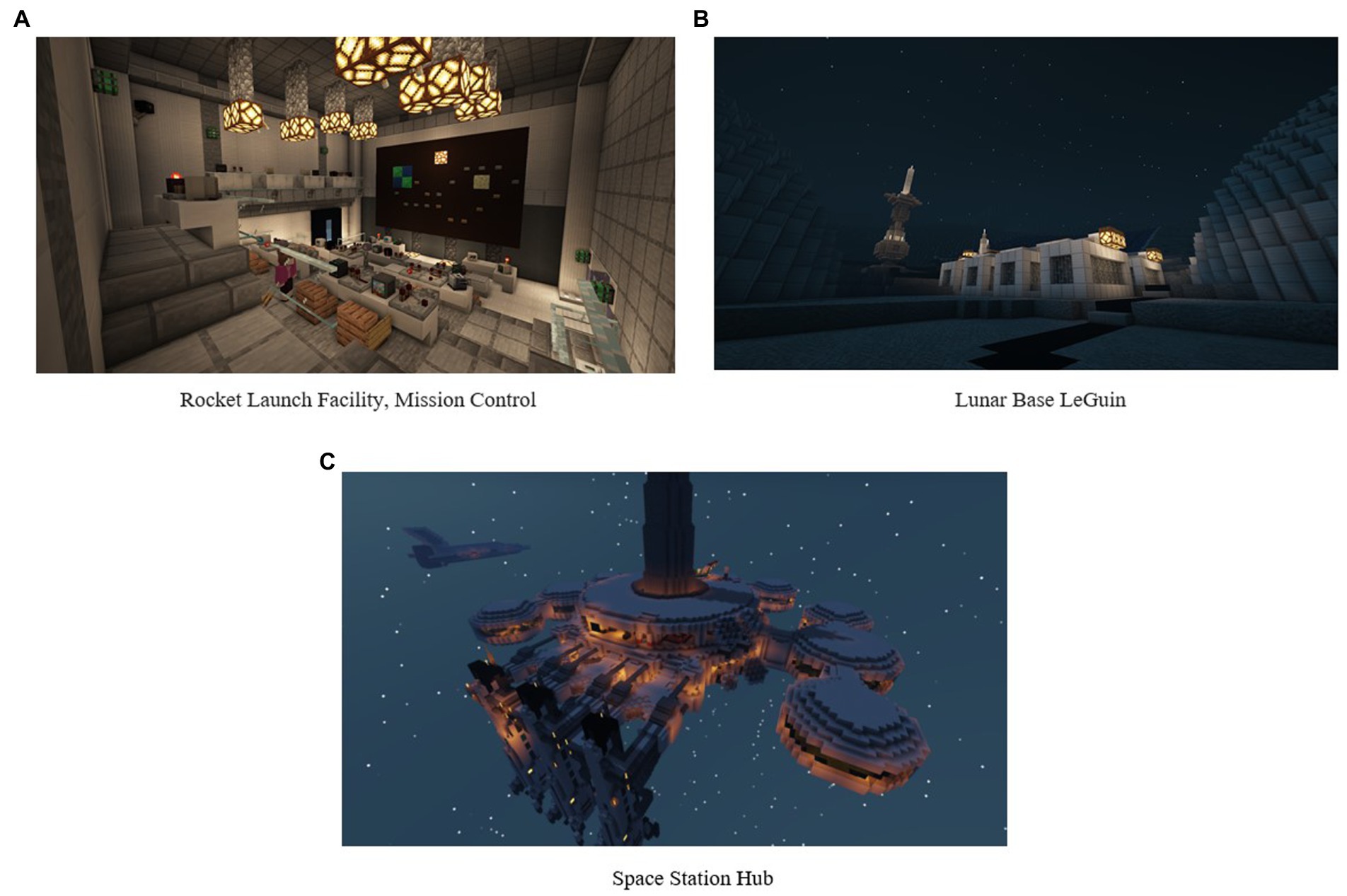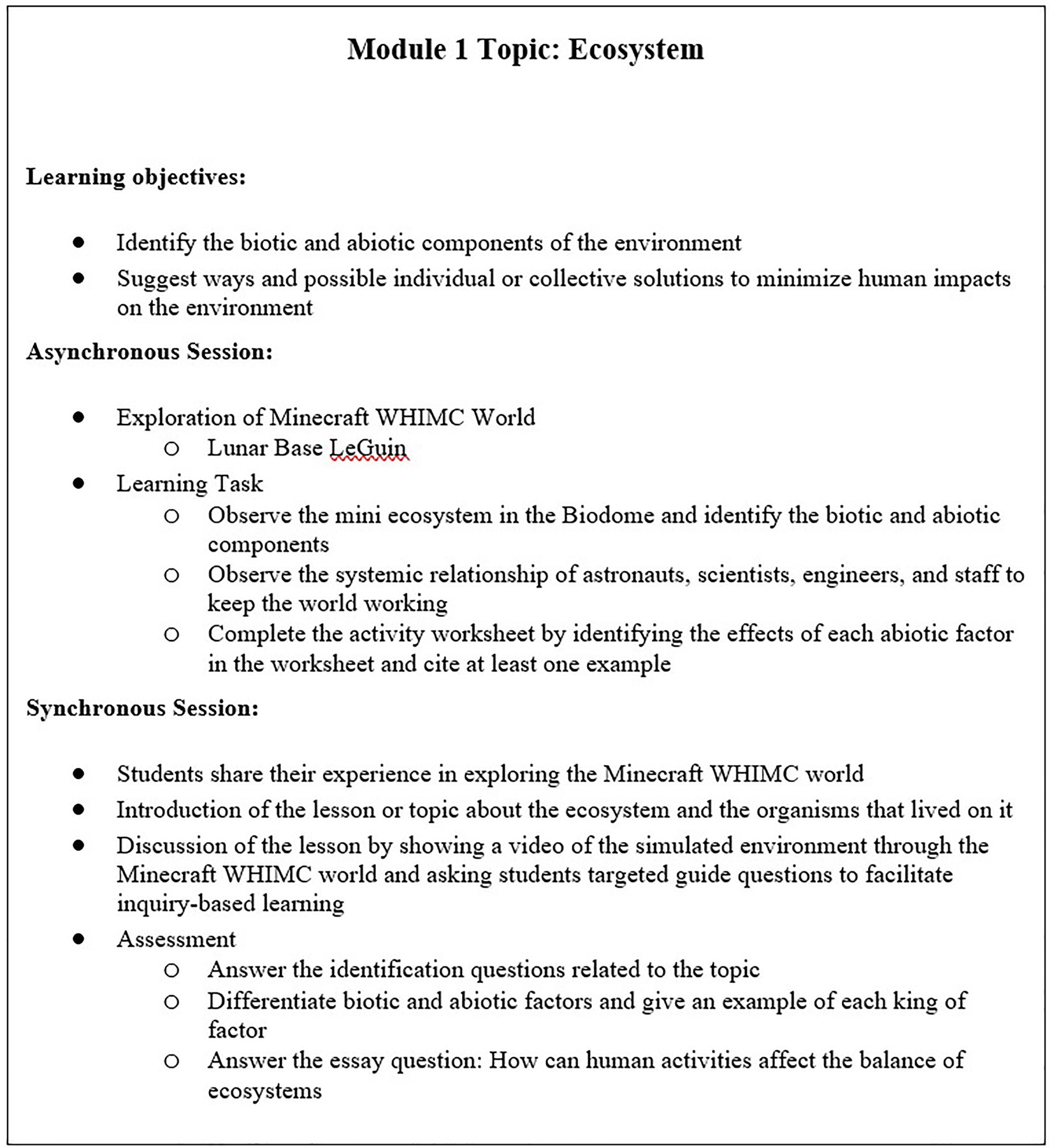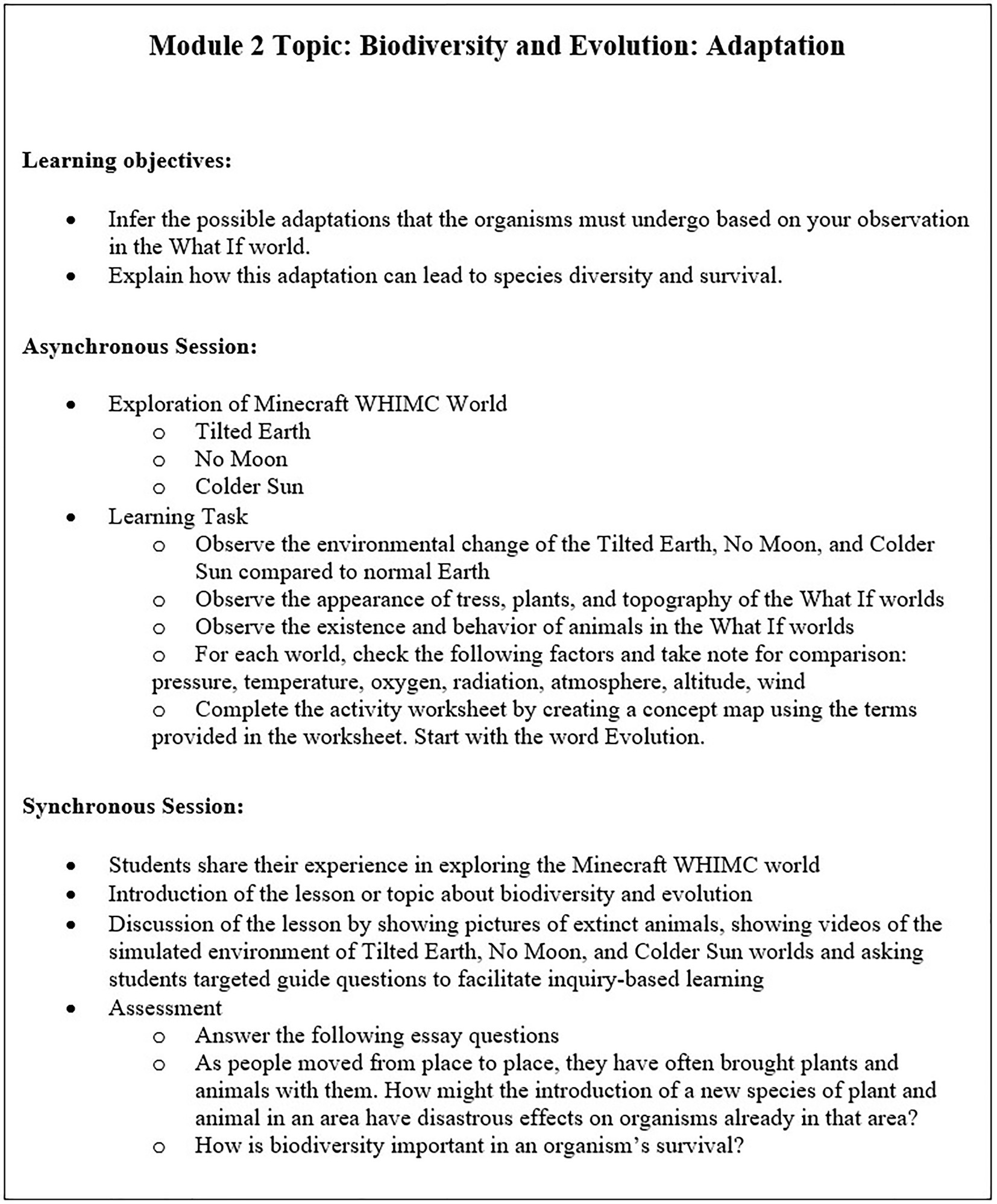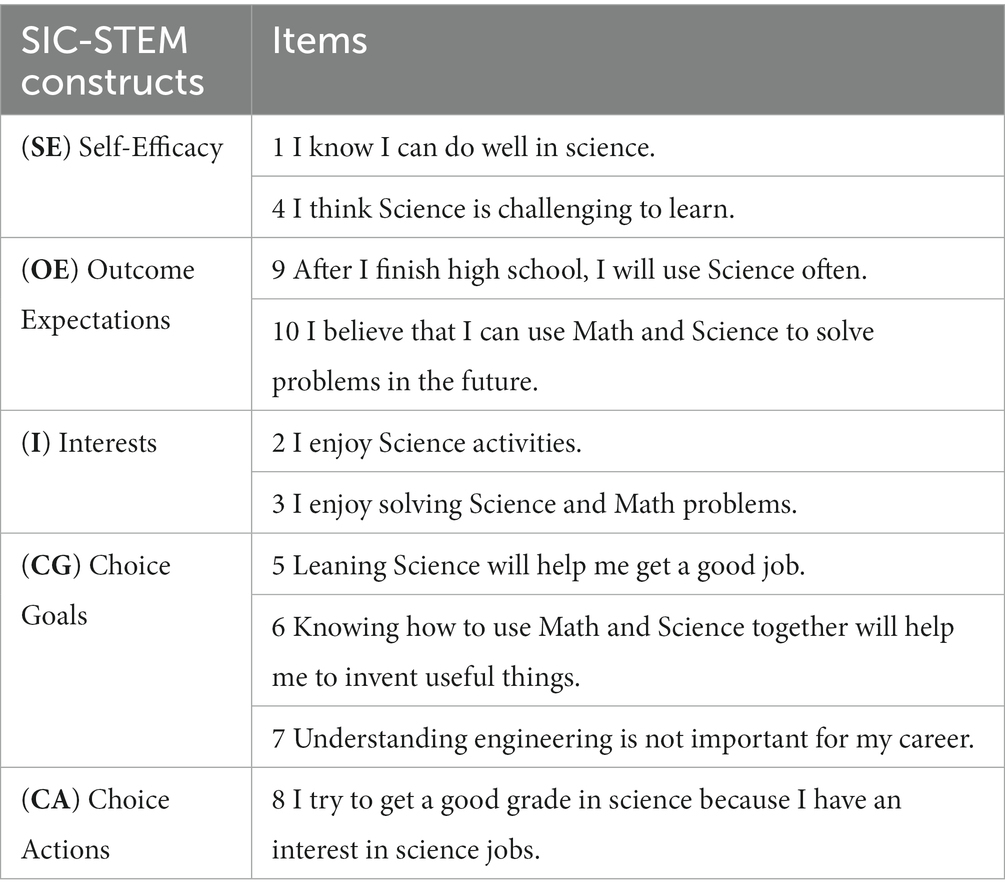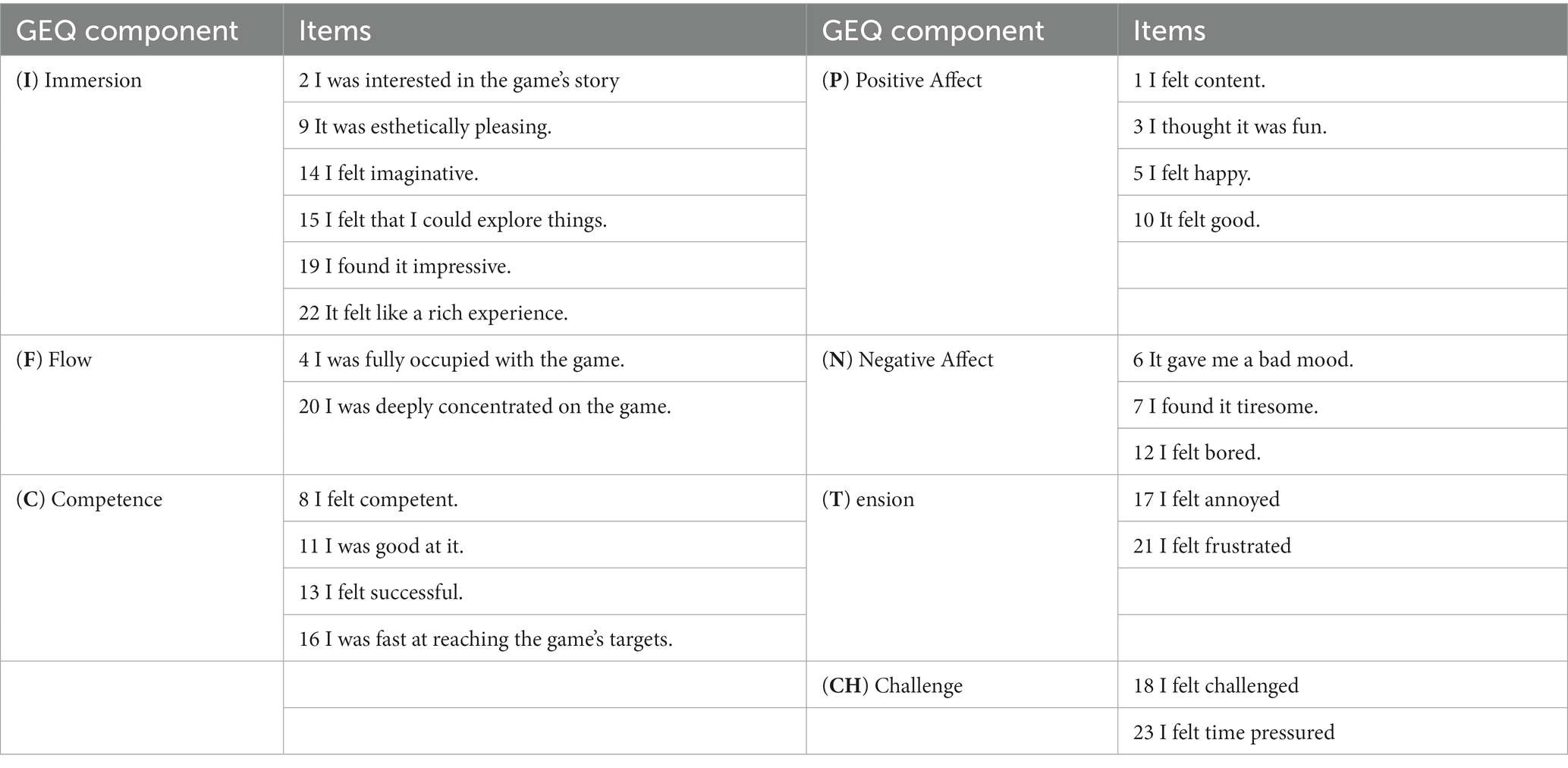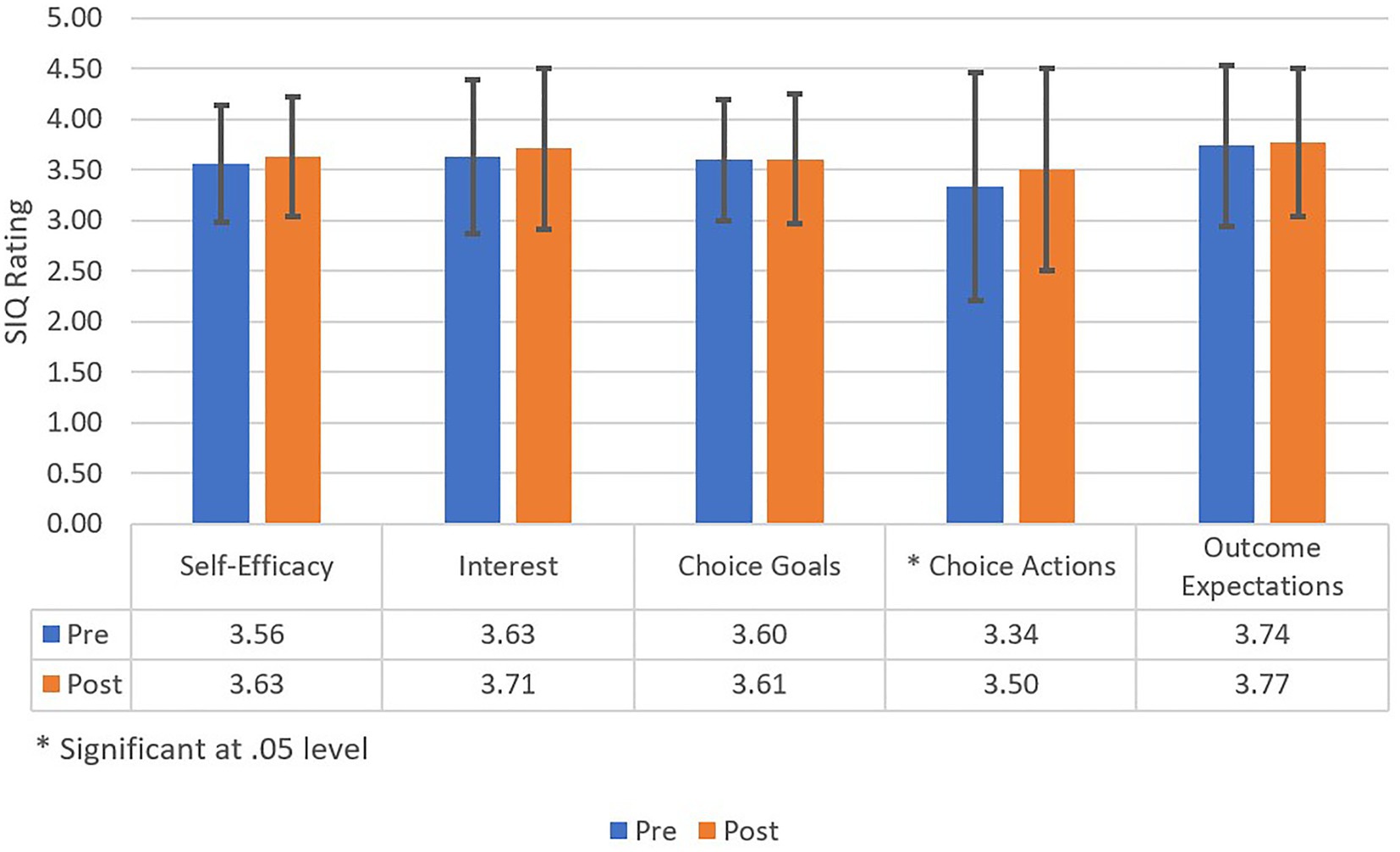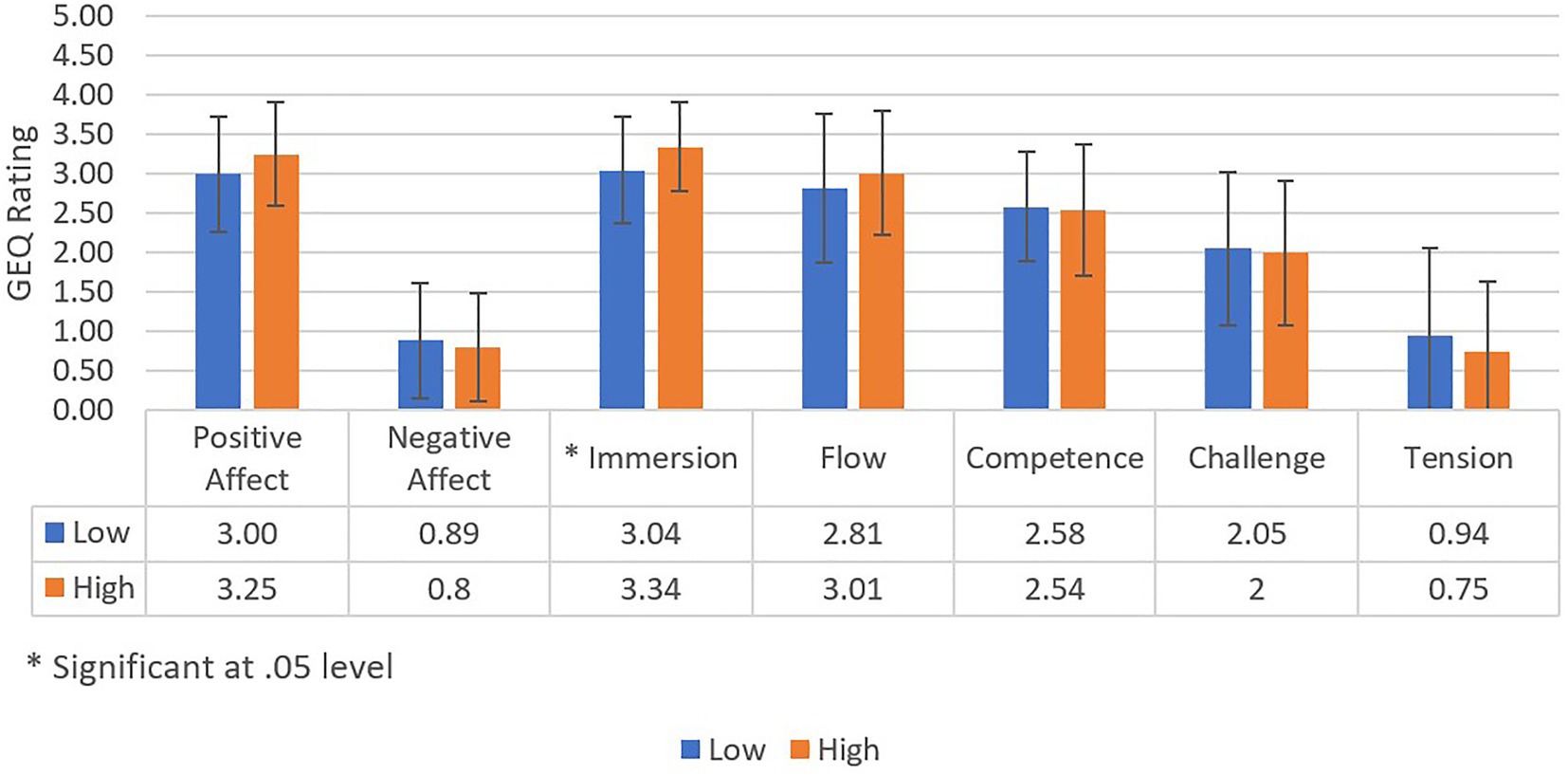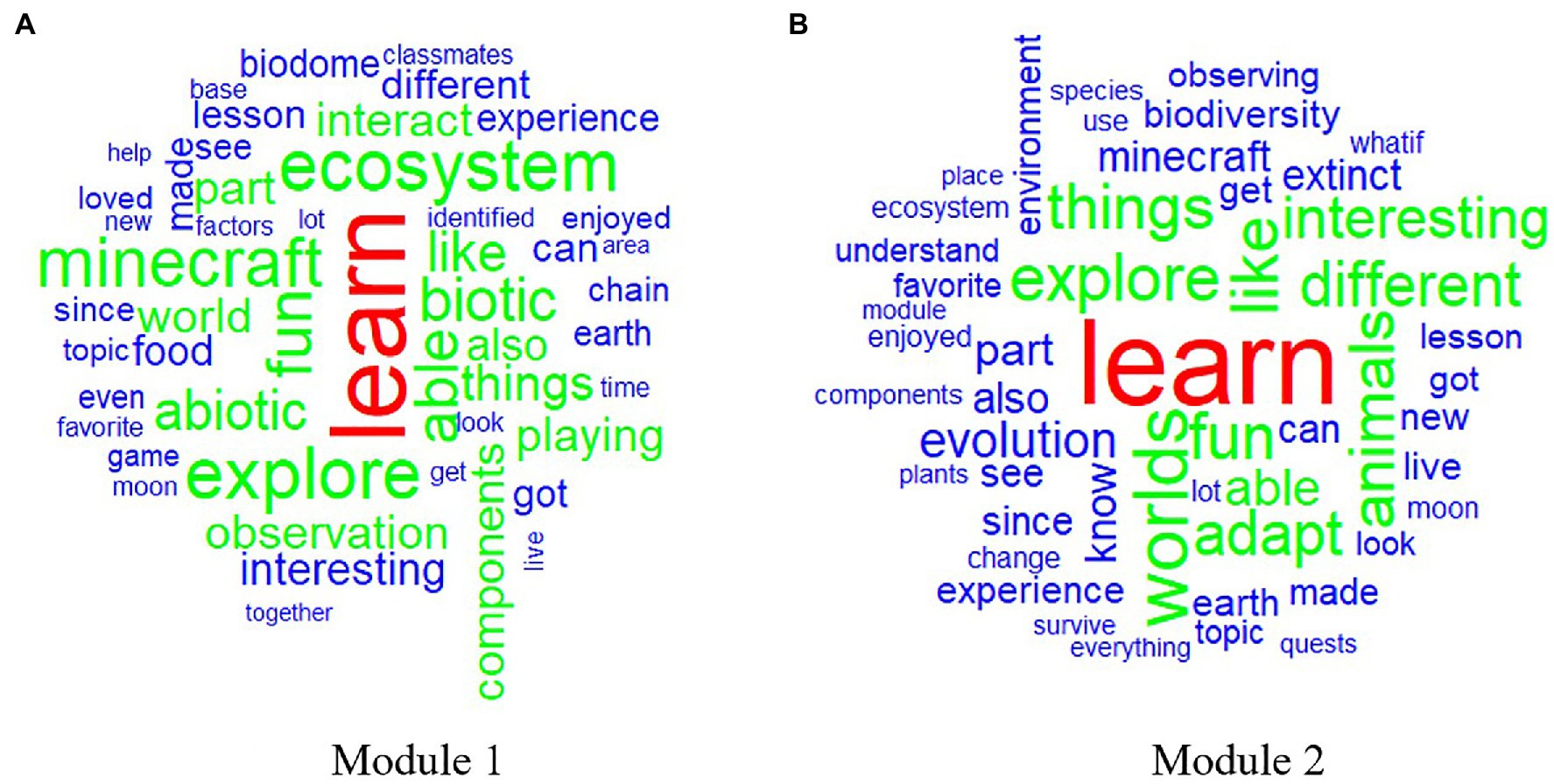- 1Ateneo Laboratory for the Learning Sciences, Department of Information Systems and Computer Science, Ateneo de Manila University, Quezon City, Philippines
- 2Information Technology Department, Pangasinan State University, Urdaneta City, Philippines
Due to the popularity and flexibility of Minecraft, educators have used this game to develop instructional materials and activities to cultivate student interests in science, technology, engineering and mathematics (STEM). One example of such an initiative is the What-If Hypothetical Implementations in Minecraft (WHIMC) project of the University of Illinois Urbana Champaign. The study reported in this paper describes a WHIMC deployment in the Philippines and the effects this deployment had on student STEM interest. The study used quantitative and qualitative methods to determine the effect of WHIMC on the STEM interest of Filipino students. We performed quantitative analysis of the pre- and post-STEM Interest Questionnaire (SIQ) ratings and Game Experience Questionnaire (GEQ) ratings of the high- and low-performers to determine the effect of using WHIMC in the students’ STEM interest and the difference between the game experience of high- and low-performers, respectively. Qualitative analysis of the answers to the open-ended questions about the attributes of the module was also conducted to determine the relationship between the module attributes and student performance. The analysis of the aggregated SIQ ratings before and after using the WHIMC-based modules revealed only a minimal effect on the STEM interests of the students. However, there was a significant effect in the Choice Actions construct, which implies that students recognize the importance of studying hard if they want to pursue STEM-related careers. Further, the analysis of the overall GEQ of high-performers and low-performers also revealed no significant difference. Although no significant difference was observed in the overall GEQ, high-performers had significantly higher GEQ ratings in the Immersion dimension. This result suggested that high-performers had a more positive, engaging, and enjoyable learning experience. Moreover, the findings on the favorite module attributes suggested that students perform better in the out-of-game assessments when they like all the module attributes. This implies that students must be engaged in the game and learning task aside from being interested in the learning topic to have better assessment scores. The study also showed that open-ended learning environments coupled with tasks that demand exploration, observation, and higher-ordered thinking are demanding even on high-performers.
1. Introduction
Learners often find STEM difficult because it requires complex thinking, repeated practice, and self-discipline (Bertozzi, 2014). According to the PISA National Report on the Philippines, compared to the OECD average of 489 in Math and 489 in Science, Filipino students scored a low 353 and 357, respectively. Only 1 out of 5 attained the minimum proficiency level in math (Education GPS, OECD, February 2023). These results are corroborated by students’ performance in the National Achievement Test, where only 25% demonstrated mastery levels in math and only 5% of test takers demonstrated mastery levels in science. Thus, addressing STEM interest and achievement in the Philippines is an acute need. Improving students’ self-efficacy through learning experiences is essential to cultivating students’ interest and enthusiasm in STEM careers (Mohtar et al., 2019). One of the innovative ways to provide an engaging learning environment that keeps students interested and enthusiastic about STEM subjects is the use of games in learning.
Digital game-based learning (DGBL) has become a growing educational trend in the classroom as an engaging teaching approach for improving student motivation and learning (Ennis, 2018; Leong et al., 2018; Hussein et al., 2019; Shang et al., 2019). Games provide more amusement, enjoyment, and aesthetic appeal (Alawajee, 2021). They can also encourage the player to learn, offer multisensory environments, and improve the capacity of a player to think and create meaning (Iliya and Jabbar, 2015). The use of digital games can help students gain a more concrete understanding of abstract, theoretical topics while interacting with the learning material (Nkadimeng and Ankiewicz, 2022). Games have been advantageous for learning in different domains, including more authentic learning and increased student engagement because of their degree of interactivity and immersion (Alonso-Fernandez et al., 2019). Since STEM subjects are complex and challenging to learn, games can be a great way to introduce learners to scientific concepts. Several studies have demonstrated the beneficial impacts of games on science education. A study on DGBL for elementary science education revealed increased student engagement, domain knowledge, and problem-solving skills (Lester et al., 2014). Students who played the personalized DGBL application about plants gained a significant increase in learning achievements and motivation (Hwang et al., 2012). In addition, students who learned about migratory bird identification with the DGBL environment have significantly outperformed their peers in the acquisition of learning and motivation (Chu and Chang, 2014). The game Sorceress of Seasons was utilized to teach fundamental programming concepts. This resulted in increased positive attitudes toward programming, with female students reporting larger increases in computer science interest than males. The study suggests that games may be successful in increasing interest in STEM (Bonner and Dorneich, 2016). Further, the simultaneous presence of learning experiences and player self-determination while playing a STEM digital game might foster STEM interest (Ishak et al., 2022). The positive effects of digital games on student achievement, skills acquisition, motivation, and engagement have influenced educators, game developers, funding organizations, and researchers to use games across many platforms to teach STEM subjects (Bertozzi, 2014).
Minecraft is one of the game platforms used to teach and encourage interest in STEM. Minecraft is a sandbox-style video game released in 2009 by Mojang and the most widely played game in the world, with more than 180 million copies sold to date (Bitner, 2021). Due to its popularity and flexibility, educators utilize this game platform to develop instructional materials and activities to cultivate student interest in STEM. Pusey and Pusey (2015) used MinecraftEdu as an instructional tool to teach Earth Science topics to Grade 8 students in 2 schools in Australia. Along with the traditional teaching methods such as worksheets, slideshows, videos, and hands-on activities, the MinecraftEdu lessons were utilized once a week throughout the 5 to 6-week Earth Science program. Students who participated in the program expressed increased enthusiasm about attending science class because they liked the interactive learning, teamwork, and enjoyable coursework. This result showed that after the use of MinecraftEdu lessons, student interest in science has increased. Nkadimeng and Ankiewicz (2022) also reported a similar finding about using MinecraftEdu for a series of five 1 h lessons in atomic structure in a South-African junior high school. Further, learning with MinecraftEdu makes abstract concepts easier to understand, promotes critical thinking, and is conducive to collaboration and motivation. Another study prepared four different STEM activities and asked 6th-grade science classes to use Minecraft Educational Edition for 4 hours per week. The researchers collected data on STEM interests using the STEM Career Interest Survey and Scientific Creativity Scale. Both scientific creativity and STEM interest levels statistically increased (Saricam and Yildirim, 2021). These results imply that MinecraftEdu might be suitable as a learning tool for Science and Chemistry subjects. Furthermore, there is evidence from prior studies that games have a positive effect on STEM interests. However, there is a lack of longitudinal studies. Indeed, papers such as those of Gao et al. (2020) call for longitudinal studies to determine game-based learning’s far-reaching effects.
What-If Hypothetical Implementations in Minecraft (WHIMC; https://whimcproject.web.illinois.edu/) also aims to engage, excite, and generate interest in learning science. WHIMC is a set of Minecraft worlds teachers can utilize as supplementary activities in teaching STEM. It includes a Rocket Launch Facility, the Lunar Base LeGuin, and a Space Station as shown in Figure 1. It also includes exoplanets and different versions of Earths, e.g., Earth with no moon, Earth with a colder sun. WHIMC immerses learners in simulated environments wherein they can move around these different worlds and make observations while exploring them (Yi and Lane, 2019; Manahan and Rodrigo, 2022; What-If Hypothetical Implementations in Minecraft (WHIMC), n.d.).
WHIMC has been the platform for several studies. One such study conducted during a summer camp examined campers’ actions by giving them a quick 10 min presentation on hypothetical earth scenarios before allowing them to explore worlds in Minecraft. It revealed that sandbox games can spark interest in STEM subjects among underrepresented adolescents and that engagements with natural phenomena are possible in an open digital environment (Yi et al., 2020). Another study (Yi et al., 2021) examined interest triggers within Minecraft and found that personal relevance relates to a desire to reengage in camp content and with the design and structure of the intervention. Further study on STEM interest triggers within Minecraft in a hybrid summer camp found that various in-game and contextual aspects of the learning experiences, such as instructional conversation, novelty, ownership, and challenge, triggered the learners’ STEM interests (Lane et al., 2022). Gadbury and Lane (2022) encouraged teenagers to participate in five after-school sessions over the course of 5 weeks, during which they used Minecraft to explore several versions of Earth. The research investigates how different levels of STEM interest affect in-game science tool usage and observations across the hypothetical versions of Earth. The result revealed that participants with moderate STEM interests had the highest science tool usage, indicating high engagement and desire to learn. In terms of observations, participants with high STEM interests recorded high observations, suggesting confidence or high prior knowledge. Studies on the use of WHIMC were also conducted in the Philippines. The analysis of learner traversals of Minecraft worlds conducted in a grade school found a negative correlation between learner performance and overall distance traveled. This finding implied that low performers wander early in gameplay while high performers use a depth-first search strategy when exploring an area and are goal-oriented (Esclamado and Rodrigo, 2022a). The study of Casano and Rodrigo (2022a) performed a comparative assessment of American and Filipino learner traversals and in-game observations within Minecraft against canonical answers from experts. The finding suggested that high performers make more observations aligned with canonical answers from experts than low performers. They also found a difference in the in-game behavior of low performers. Filipino students tend not to make in-game observations, while American students actively make in-game observations. Another study looked at the achievement, behaviors, and STEM interests of frustrated and bored learners using WHIMC and found that frustrated learners tend to disengage from the game and bored learners tended to perform poorly on post-game assessments (Esclamado and Rodrigo, 2022b). Further, the analysis of game experience and STEM interest of primary school learners in the Philippines reported that high and low performers had the same level of game experience and that they like the game and learning-related WHIMC features. However, the learning task integrated into the WHIMC-based modules made learning difficult for the high performers, and technical bugs made learning difficult for the low performers. The finding on the STEM interest showed that high performers had a higher degree of agreement with the Stem Interest Questionnaire (SIQ) compared to the low performers (Casano and Rodrigo, 2022b). This study aims to continue the Philippine studies by promoting the use of WHIMC as a learning tool in a Philippine middle school to cultivate student STEM interests. Specifically, we seek answers to the following research questions:
RQ1: What is the effect of using WHIMC on the STEM interests of students?
RQ2: What is the difference between the game experience of high- and low-performers?
RQ3: What is the relationship between the module attributes and student performance?
2. Materials and methods
The study used quantitative and qualitative methods to determine the effect of WHIMC on the STEM interests of Filipino students. We used an embedded design wherein we collected quantitative data from the SIQ and Game Experience Questionnaire (GEQ) survey questionnaires and qualitative data from the open-ended questions included in the GEQ questionnaire. Insights drawn from analyzing the answers to the open-ended questions about the module attributes might support the observations from the quantitative analysis of the SIQ and GEQ ratings. Therefore, we first performed quantitative analysis of the pre-SIQ and post- SIQ ratings and GEQ ratings of the high- and low-performers to determine the effect of using WHIMC in the students’ STEM interests and the difference between the game experience of high- and low-performers, respectively. We then performed a qualitative analysis of the answers to the open-ended questions on the attributes of the module to determine the relationship between the module attributes and STEM interests. The research protocol was reviewed and approved by the University Research Ethics Committee of the Ateneo de Manila University.
2.1. Teacher-created learning modules
The research team established a formal partnership with the University of Illinois Urbana-Champaign (UIUC) team to gain access to WHIMC’s content, code, and configuration details. A parallel server was then set up in the Philippines to run the experiments and manage the tasks without constantly coordinating with the UIUC team. After that, the research team established institutional partnerships with elementary and middle schools in the Philippines. Partner teachers were recruited, informed about the project goals, and requested to design WHIMC-based learning modules and out-of-game assessments. The research team gave the partner teachers 30 days to explore the WHIMC worlds to familiarize themselves with the game. The partner teachers then chose specific topics within their respective academic curriculum levels where they thought a particular WHIMC world would fit. The partner teachers and the research team reviewed the learning modules for quality, viability, and curriculum alignment before using these modules in class. The research team then provided documentation to assist the partner teachers in preparing for the WHIMC module implementation. The project manager also gave the partner teachers Minecraft account credentials to be used by the participating students in their class before the module implementation. Only the partner teacher engaged with the students during the module implementation in the class sessions. However, members of the research team were available inside the Minecraft server to assist in resolving potential student problems. The research of Manahan and Rodrigo (2022) provides a more thorough explanation of the preparation and support given to partner teachers and their classes in integrating and implementing WHIMC in their curriculum.
In this study, the partner teachers from a middle school in the Philippines developed two (2) learning modules for their Grade 8 science curriculum. Since Minecraft uses a biome system and adopts representation of real-world animals (Ekaputra et al., 2013), the partner teachers utilized WHIMC to teach topics on ecology. The partner teachers chose ecosystem as the topic for Module 1 and biodiversity and evolution for Module 2. The developed modules employed asynchronous and synchronous teaching modalities. The learning modules implemented a self-discovery teaching strategy where students are provided access to the WHIMC worlds before the 1 h synchronous sessions to give students ample time to explore, provide observations, and infer an understanding of the worlds. The Minecraft game-play was integrated into the modules as a pre-lecture and motivation activity. Wang et al. (2022) found that students at different educational levels respond differently to games. Primary school students are at a developmental stage where they are unable to master the rules of the games quickly and are therefore attracted by the freshness and novelty of games. However, secondary and higher education students master the game rules quickly, resulting in decreased interest. Thus, the Minecraft game-play integrated into the module has no specific time limit to allow students to explore the worlds at their own pace. However, each Minecraft session must be completed before the synchronous session. Students need to complete 2 Minecraft game-play sessions. The learning tasks integrated into the WHIMC-based modules were designed to apply a number of higher-order thinking skills represented in Bloom’s taxonomy. The game attribute of the modules consists of the exploration of the simulated environment of the WHIMC worlds. Students underwent training and orientation in Module 1, wherein they explored the space station and experienced the hub that supports life. They explored the built-in ecosystem of the Lunar Base LeGuin to identify the biotic and abiotic components and observe the systemic relationships of the staff in the area. In Module 2, students explored the What-If worlds, wherein they experienced the life of an astronaut. They also experienced different What-If scenarios of the planet Earth (Tilted Earth, No Moon, Colder Sun) that showed them opportunities to observe the planet under altered conditions. The observation of the students must revolve around the environmental change of the different versions of Earth compared to normal Earth, the appearance of trees, plants, and topography, the existence and behavior of animals, and compare the pressure, temperature, oxygen, radiation, atmosphere, altitude, and wind for each world.
Each module began with an asynchronous session in which students explored the WHIMC worlds and recorded their observations as indicated in the module. After the asynchronous session, students turn in their answers for the formative assessments and activity worksheets. The 1 h synchronous session focused on the discussion of the lesson using simulations and inquiry-based learning to encourage student active participation, followed by a knowledge assessment related to the topic. See Figures 2, 3 for the excerpt of the developed WHIMC-based modules.
2.2. Participants
The entire Grade 8 school population consisting of 8 class sections were recruited for the study. However, out of the 212 prospective participants, 31 opt not to participate and 64 did not complete the survey questionnaires they were asked to answer. Thus, the total participants in this study were 117 middle school students (53 male and 64 female) aged 13–14 years old. The collection of data from the participants was approved by the University Research Ethics Office (UREO). The students submit the signed consent forms indicating their participation in the experiment prior to data collection. The data used in the analysis come from the Stem Interest Questionnaire (SIQ) ratings, Game Experience Questionnaire (GEQ) ratings, and answers to the open-ended questions about the module attributes, alongside the performance ratings (high or low) of the participants.
2.3. Pre-test and post-test
Before using WHIMC, the students complete the pre-SIQ to determine their baseline interest in these domains. The students took knowledge assessments, the GEQ, and the post-SIQ as post-test after using WHIMC. The SIQ was given as a pre-test and post-test to determine whether using the WHIMC-based modules made an impact on the STEM interests of students.
2.4. Knowledge assessment
Students took knowledge assessments after the asynchronous and synchronous sessions of each module. The out-of-game assessments consisted of formative evaluations, asynchronous worksheets, and long tests. The observations made by the students while using WHIMC served as formative evaluations. After the asynchronous session, students must complete the asynchronous worksheets associated with each module topic. Further, long tests consisting of identification and essay questions related to the module topics were administered after the synchronous sessions. High-performers and low-performers were identified based on their out-of-game assessment scores. High-performers (HP) are those students with total assessment scores exceeding the mean score (HP = s > x̄). Conversely, low-performers (LP) are those students with total assessment scores below or equal to the mean score (LP = s ≤ x̄).
2.5. Stem interest questionnaire
The pre-SIQ determined their interests prior to using WHIMC. After answering the SIQ, students were given access to the WHIMC worlds and instructed to follow the guidelines described in the teacher-created learning modules. Students then answered the post-SIQ and the Game Experience Questionnaire (GEQ) after using WHIMC. The out-of-game assessment questions that are part of the teacher-created learning modules were then given to the students to complete the data collection process.
The SIQ used in this study is an abridged version of an original Student Interest and Choice in STEM (SIC-STEM) questionnaire developed by Roller et al. (2018), which was based on the Social Cognitive Career Theory (SCCT) questionnaire of Lent and Brown (2008). This instrument is employed to characterize and assess the propensity of students to pursue STEM careers. In this framework, five dimensions (SCCT constructs) are identified to describe STEM interests: Self-efficacy: the judgment of one’s perceived ability; Outcome Expectations: the perceived consequences of one’s decisions and; Interests: the affinities of a person; Choice Goals: the perception that the choice to acquire STEM-related knowledge is important in the future; and Choice Actions: the perception that STEM-related actions today will provide support in a future career.
The SIQ used in this study consisted of 10 items from the SIC-STEM questionnaire based on their relevance to WHIMC and the teacher-created learning modules. The respondents rate their level of agreement using a 5-point Likert scale format (1 – strongly disagree, 2 – disagree, 3 – neutral, 4 – agree, 5 – strongly agree). Table 1 presents the mapping of the SIQ items to the SIC-STEM constructs.
2.6. Game experience questionnaire
The GEQ used in this study is also an abridged version of the instrument developed by IJsselsteijn et al. (2013) to measure the factors in a game that contribute to an engaging gameful experience described across seven (7) dimensions of the player experience namely, Immersion: how strongly the players felt connected to the game; Flow: how much the player lost track of their own effort or time while playing the game; Competence: the player’s judgment of their own performance against the game’s goals; Positive Affect and Negative Affect: reports of positive and negative emotional experiences while playing the game; Tension: reports relating to frustration and annoyance; and Challenge: an indication of how difficult the players found the game to be. Johnson et al. (2018) validated the GEQ used in this study and the findings suggest a revised structure that reduces the seven dimensions to five factors. Flow, immersion, competence, and positive affect dimensions have some empirical support. However, it was noted that items in the negative affect, tension, and challenge dimensions overlap and should not be evaluated independently. It would be more acceptable to see these aspects as being merged into a single negative factor. Since we wanted a fine-grained analysis of the negative gaming experience of the students while using WHIMC, we treated the negative affect, tension, and challenge dimensions separately.
The questionnaire used in this study was adopted from Casano and Rodrigo (2022b). The instrument only included 23 items that seemed relevant to the context of WHIMC and the teacher-created learning modules out of the 33 core module items of the original GEQ. The respondents rate their level of agreement with the items using a 5-point Likert scale format (not at all - 1, slightly - 2, moderately - 3, fairly - 4, extremely - 5). Table 2 presents a mapping of the GEQ items to the player experience components.
Four (4) open-ended questions were appended to the GEQ. These questions were: What was your favorite part of the module and why?; What was your least favorite part of the module and why?; What about WHIMC made the topic fun, interesting, or easy to learn?; and What about WHIMC made the topic boring and/or difficult to learn?.
2.7. Data analysis
To answer the research questions of this study, we conducted statistical analyses of the pre-SIQ and post-SIQ, GEQ, and answers to the open-ended questions on the module attributes. Paired samples t-test was used to analyze the pre-SIQ and post-SIQ ratings of the students to determine the effect of using WHIMC on the STEM interests of students. Independent samples t-test was used to compare the game experience between the high-performers and low-performers using their GEQ ratings. A point-biserial correlation was used to determine the strength and direction of association of each favorite module attribute between the high-performers and low-performers.
For the qualitative analysis, the text data (responses to the favorite and least favorite open-ended questions on module attributes) were analyzed using thematic analysis. The text data were assessed and tagged by coders as being related to the learning topic, learning task, or game attribute of the teacher-created learning module.
The resulting dataset was then subjected to the bag-of-words approach for text analytics. In particular, pre-processing was conducted to transform the text data into a quantifiable form. The text data was converted into lowercase form, removal of punctuations, special symbols, numbers, and extra whitespaces, stopwords (pronouns and other common yet irrelevant words), stemming (transformation to base form), and stem completion (transformation to sensible form). Finally, the text data were tokenized and transformed into a document-term matrix.
The transformed text data was then merged with the performance and thematic tagging data, and were then subjected to statistical treatments. Descriptive visualizations were employed to characterize the responses of the students. Word clouds were used to show the relative frequencies of dominant words for each module and each type of response (favorite or least favorite attribute).
3. Results
3.1. Analysis of SIQ ratings
The students answered the SIQ twice: before and after playing WHIMC. A paired-samples t-test was conducted to compare the SIQ ratings of the students before and after using WHIMC as a learning tool. The analysis of the SIQ ratings revealed that there was no significant difference in the overall pre-SIQ ratings (M = 3.60, SD = 0.27) and post-SIQ ratings (M = 3.65, SD = 0.29) using WHIMC; t(116) = −1.78, p = 0.077. There is only a slight increase in the overall SIQ ratings after using WHIMC. This result suggests that using WHIMC as a learning tool only has a minimal effect on the STEM interests of the students.
To conduct further analysis on the SIQ ratings, paired samples t-tests were conducted to compare the SIQ ratings of the students before and after using WHIMC on the different SIC-STEM constructs. The result of the statistical analysis revealed that only the Choice Actions construct of the 5 SIC-STEM constructs showed a statistically significant difference. The pre-SIQ rating of the Choice Actions construct (M = 3.34, SD = 1.13) significantly increased after using WHIMC (M = 3.50, SD = 1.00); t(116) = −2.263, p = 0.025. This result indicates that the students understood the importance of studying hard and earning high marks in class if they are interested in STEM-related careers. Figure 4 presents the bar chart showing the aggregated pre-SIQ and post-SIQ ratings on each SIC-STEM construct.
Figure 5A shows the bar charts of the pre-SIQ and post-SIQ ratings on each SIC-STEM construct of the low-performers. Paired-samples t-tests were conducted on each construct and results show that the pre-SIQ rating for the Self-efficacy construct (M = 3.49, SD = 0.59) significantly increased after using WHIMC (M = 3.63, SD = 0.67); t(53) = −2.127, p = 0.038. This finding might indicate that the low-performers gained some confidence in their ability to understand science concepts.
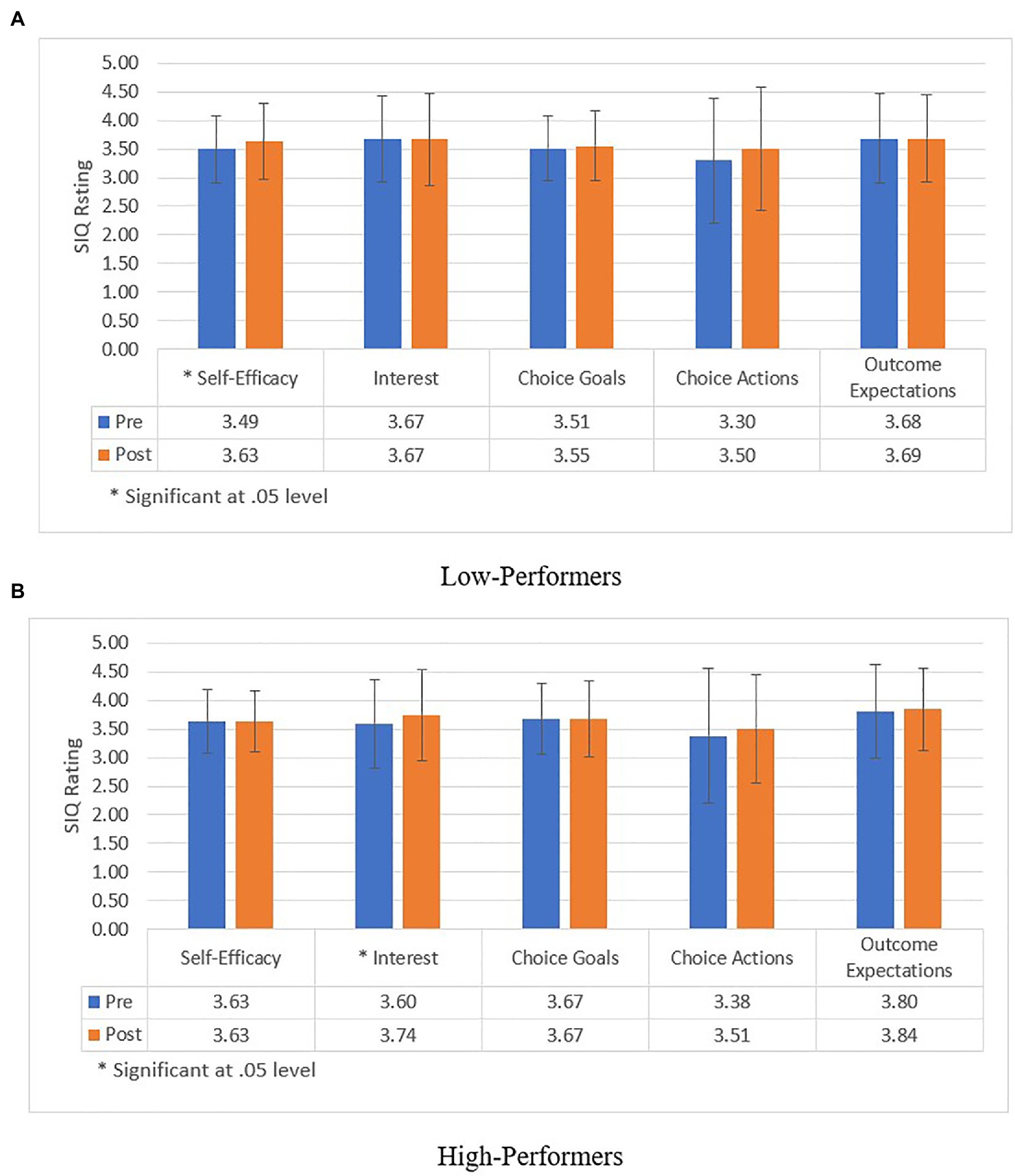
Figure 5. Pre- and post-SIQ ratings on each SIC-STEM construct, (A) Low-performers. (B) High-performers.
Figure 5B shows the bar charts of the pre-SIQ and post-SIQ ratings on each SIC-STEM construct of the high-performers. Paired-samples t-tests were conducted on each construct and results revealed that the pre-SIQ rating for the Interest construct (M = 3.60, SD = 0.77) significantly increased after using WHIMC (M = 3.74, SD = 0.80); t(62) = −2.092, p = 0.041. High-performers’ increased level of agreement in the Interests construct may be related to how much they enjoyed and persisted in completing the assigned tasks from the WHIMC-based modules.
The observations on the analysis of each SIC-STEM construct provided some evidence that the teacher-created learning modules using WHIMC increased some aspects of STEM interest among students.
3.2. Analysis of the GEQ answers
The GEQ was administered to measure the factors in a game that contribute to an engaging gameful experience described across 7 dimensions of the player experience: Positive Affect (PA), Negative Affect (NA), Immersion (I), Flow (F), Competence (C), Challenge (Ch), and Tension (T). Independent samples t-test was used to determine if there is a significant difference in the overall GEQ ratings between the high- and low-performers. The statistical test result revealed no statistically significant difference in the overall GEQ ratings between the high-performers (M = 2.48, SD = 0.13) and low-performers (M = 2.38, SD = 0.19); t(103) = −1.311, p = 0.193. This result revealed that both groups had the same level of engagement in using WHIMC as a learning tool. Independent samples t-tests were used on each dimension to check for differences between high- and low-performers. The tests revealed that only the Immersion dimension had a significant difference between the groups. High-performers have significantly higher GEQ ratings (M = 3.34, SD = 0.56) compared to the low-performers (M = 3.04, SD = 0.68) after using WHIMC; t(106) = −2.584, p = 0.011. This finding suggested that high-performers connected more deeply with the game and may therefore have had a more engaging learning experience than low-performers. Figure 6 shows the GEQ ratings of the high- and low-performers on each GEQ dimension.
3.3. Analysis of the open-ended answers
Insights drawn from analyzing the answers to the open-ended questions about the module attributes might complement the observations from the analysis of the SIQ and GEQ ratings discussed in the previous sections. We conducted qualitative analysis of the responses to the open-ended questions to determine the relationship between the module attributes and student performance.
The individual answers of the students about their favorite and least favorite attributes of the module were assessed and tagged as feedback about the learning topic, learning task, or game module attribute. Three coders categorized 468 rows of open-ended answers using the criteria described in Table 3. The coders coded independently using a spreadsheet containing the class numbers with the corresponding open-ended answers and three (3) columns with headings indicating the three module attributes. Each coder tagged the open-ended answer by filling in the columns with either 1 or 0 indicating the presence or absence of the module attribute in the feedback. The coders unanimously coded 995 (70.87%) module attributes, two (2) coders were in agreement for the 383 (27.28%) module attributes, and 26 (1.85%) module attributes were coded differently by each coder. The coders then convened to reach a consensus on the differences in the coding.
3.3.1. Analysis of the answers to the favorite part of the module
The 234 rows of labeled data containing the values of favorite module attributes were analyzed using frequency count to determine the favorite module attributes and the number of favorite attributes. A point-biserial correlation was also performed to determine the strength and direction of association of each favorite module attribute between the high-performers and low-performers. This statistical analysis was utilized since the nature of the data is dichotomous.
The bag-of-words text analytics approach was then applied to the text data. The transformed text data was then merged with the performance for quantitative text analytics. This analysis was performed to characterize the text data and identify the underlying themes.
Figure 7A shows that the favorite module attribute of both groups is the learning topic of the modules. This result implies that high-performers and low-performers enjoyed the lessons integrated into the WHIMC-based learning modules. High-performers liked all the module attributes except the learning task attribute of Module 2. On the other hand, low-performers prefer the learning topic module attribute over the learning task and game module attributes.
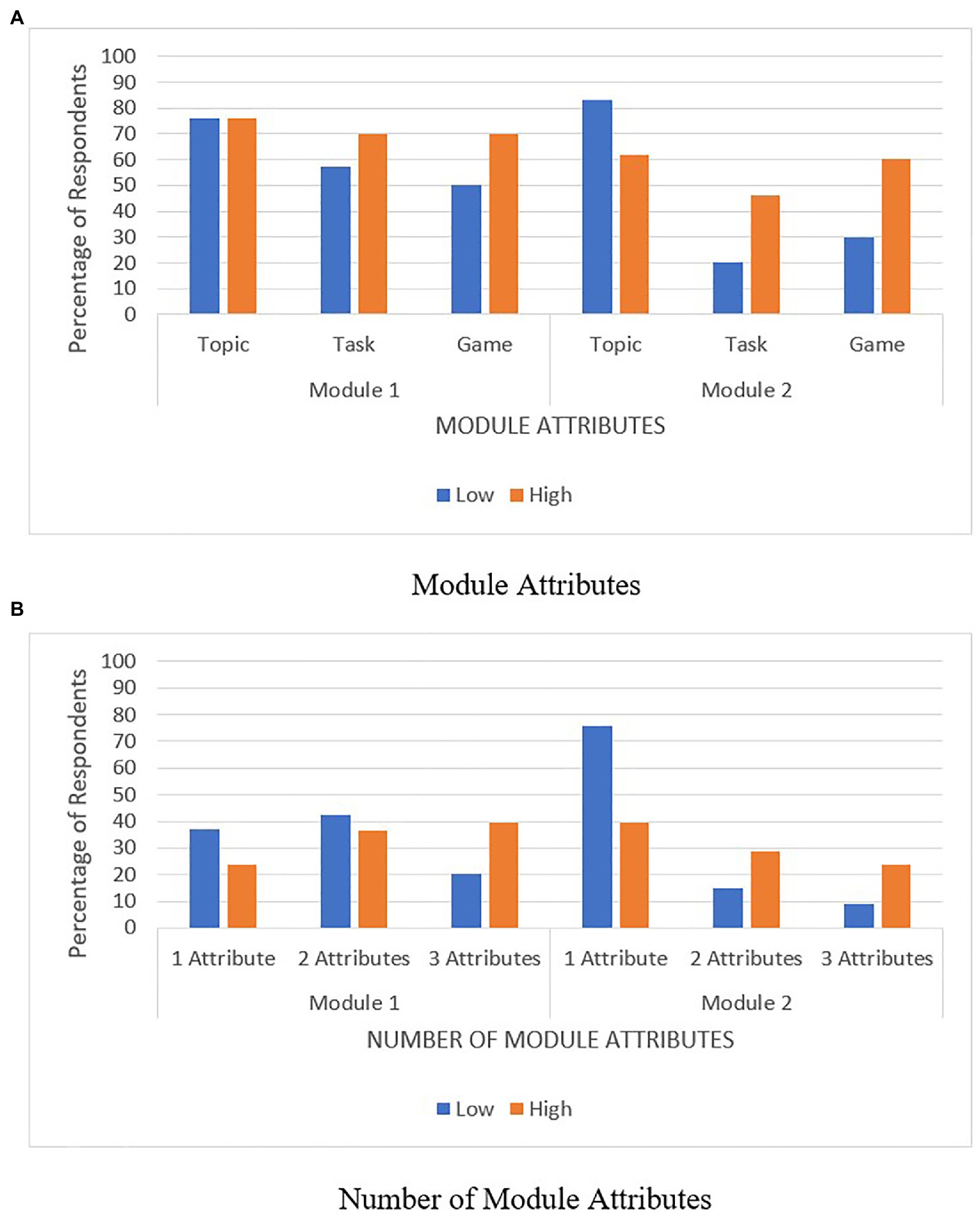
Figure 7. Responses on favorite module attributes, (A) Module attributes, (B) Number of module attributes.
The percentage of respondents on the number of favorite attributes (Figure 7B) revealed that most of the low performers mentioned 2 module attributes whereas high performers mentioned 3 module attributes in their responses about their favorite attributes in Module 1. However, for Module 2, both groups identified only one (1) module attribute as their favorite. Based on the data presented in Figure 7A, low-performers chose the learning topic and tasks as their favorite module attributes of Module 1. Further, both groups liked the learning topic more than the learning task and game module attributes of Module 2.
Table 4 presents the point-biserial correlation result of the favorite module attributes. The table shows a significant positive correlation between the game module attribute and performance (rpb = 0.203, n = 117, p = 0.029). This implied that students who liked the game attribute of Module 1 performed better in the out-of-game assessments. For Module 2, the performance has significant positive correlation with the learning task (rpb = 0.270, n = 117, p = 0.003) and game (rpb = 0.307, n = 117, p = 0.001) module attributes while a significant negative correlation was observed for the learning topic (rpb = −0.237, n = 117, p = 0.010). This finding could mean that students who chose the learning topic module attribute as their favorite did not perform well in the assessment. In contrast, students who performed better in the assessment chose the game or learning task module attribute as their favorite part of the module. We also found a significant positive correlation between the number of favorite attributes of Module 1 (rpb = 0.208, n = 117, p = 0.024) and Module 2 (rpb = 0.212, n = 117, p = 0.022) with the performance.
These findings corroborate the result of the analysis of the GEQ ratings that high performers had a better quality of game experience compared to low performers. Students who liked the game and learning task module attributes are likely to perform better in the out-of-game assessments. We note that 2 out of the 3 out-of-game assessments are conducted after exploring the WHIMC worlds assigned in the modules. Thus, students must be engaged in the game and learning tasks to have better assessment scores.
To characterize the responses of the high- and low-performers to the open-ended questions, word clouds were generated. As can be seen in Figure 8A, the most dominant word about the favorite attribute of Module 1 is learn. This finding suggests that both high performers and low performers mentioned learning in their responses. The other dominant words such as Minecraft and fun refer to the simulated environment using WHIMC, which is related to the game attribute of the module. The words ecosystem, biotic, and abiotic are related to the topic or lessons in Module 1. The word explore might be related to the learning task module attribute since students were asked to explore the WHIMC world Lunar Base LeGuin to identify the biotic and abiotic components and make observations about the systemic relationships of the people. This finding is aligned with the results of the quantitative analysis of the tagged text data since the dominant words relate to all the module attributes.
Similar to the findings in the responses about the favorite attributes of Module 1, learn is also the top word in the responses about the favorite attribute of Module 2 (Figure 8B). The words different, worlds, explore, and fun might refer to the ability of the students to explore the different worlds and the fun experience they had using WHIMC. These words are related to the game attribute of the module. The words that relate to the learning topic attribute are animals, things, interesting, and adapt. Students did not mention much in their responses about quests and observations, which are words related to the learning task attribute. This result indicates that while the students enjoyed the learning topic and game component of Module 2, they were less enthusiastic about the learning tasks.
3.3.2. Analysis of the answers to the least favorite part of the module
The same analysis discussed in the analysis of the answers to the favorite part of the module was also utilized to draw insights about the least favorite part of the module.
Based on Figure 9A, the game and learning task attributes of Module 1 are the least favorite. This result might be because students encountered technical difficulties while playing and experienced a hard time completing the quests or tasks assigned in the module. For Module 2, most of the comments come from the high-performers and they identified the learning task module attribute as their least favorite. This might be because of the many tasks assigned in this module and the need to go through 3 What-If worlds, which require more time to complete and more observations to be recorded while playing the game.
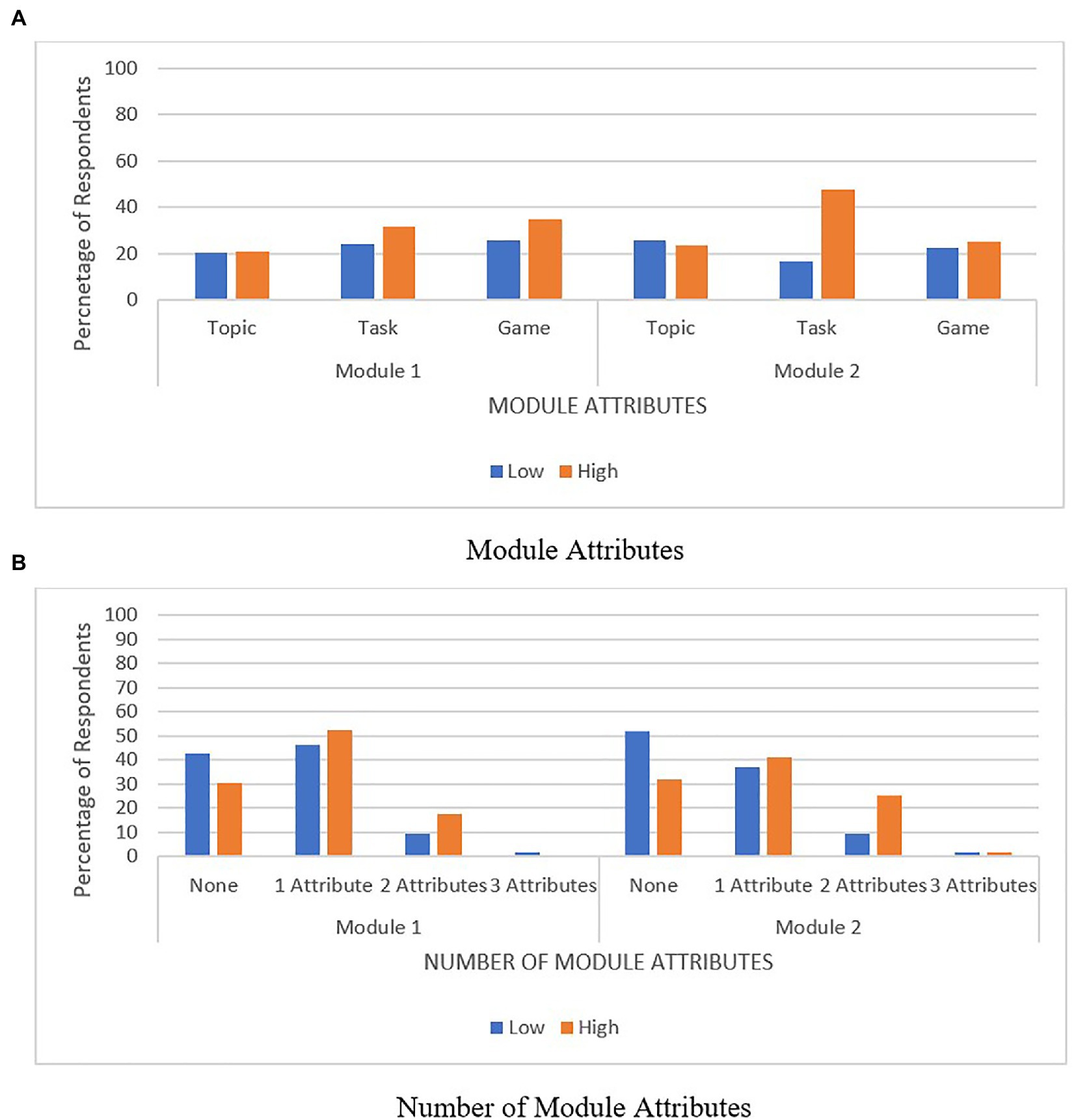
Figure 9. Responses on Least Favorite Module Attributes. (A) Module Attributes, (B) Number of Module Attributes.
Figure 9B presents the number of least favorite attributes of the high- and low-performers. We can observe that at least 1 module attribute has been mentioned by both groups. The game attribute of Module 1 as shown in Figure 9A was identified to be the least favorite of both groups. However, for Module 2, most of the low-performers did not have a least favorite whereas high-performers mentioned at least one least favorite module attribute. The high-performers are less enthusiastic about the learning task module attribute.
The result of the point-biserial correlation shows that the attributes of Module 1 and the number of least favorite attributes have no significant correlation with student performance as shown in Table 5. This result could mean that although students mentioned attributes of the module that they do not like, it does not influence their performance. In terms of Module 2, the Task module attribute has a significant positive correlation with student performance (rpb = 0.327, n = 117, p = <0.001) and the number of favorite attributes (rpb = 0.202, n = 117, p = 0.029). The result implies that students who mentioned the Task module attribute as their least favorite perform better than those who did not. When high-performers comment about the learning task module attribute, this might be because they experienced a hard time doing the assigned tasks but are still motivated to complete them.
To characterize the responses of the high- and low-performers to the open-ended questions on the least favorite module attributes, word clouds were generated. The top five dominant words for the responses on the least favorite attributes of Module 1 (Figure 10A) are time, Minecraft, hard, going, and confusing. These words describe the experience that the students had while playing WHIMC. Students mentioned in their comments that they had a hard time connecting to Minecraft, going to different worlds or portals, and sometimes being confused about what to do next. This finding implies that most of the comments are related to the game attribute of the module.
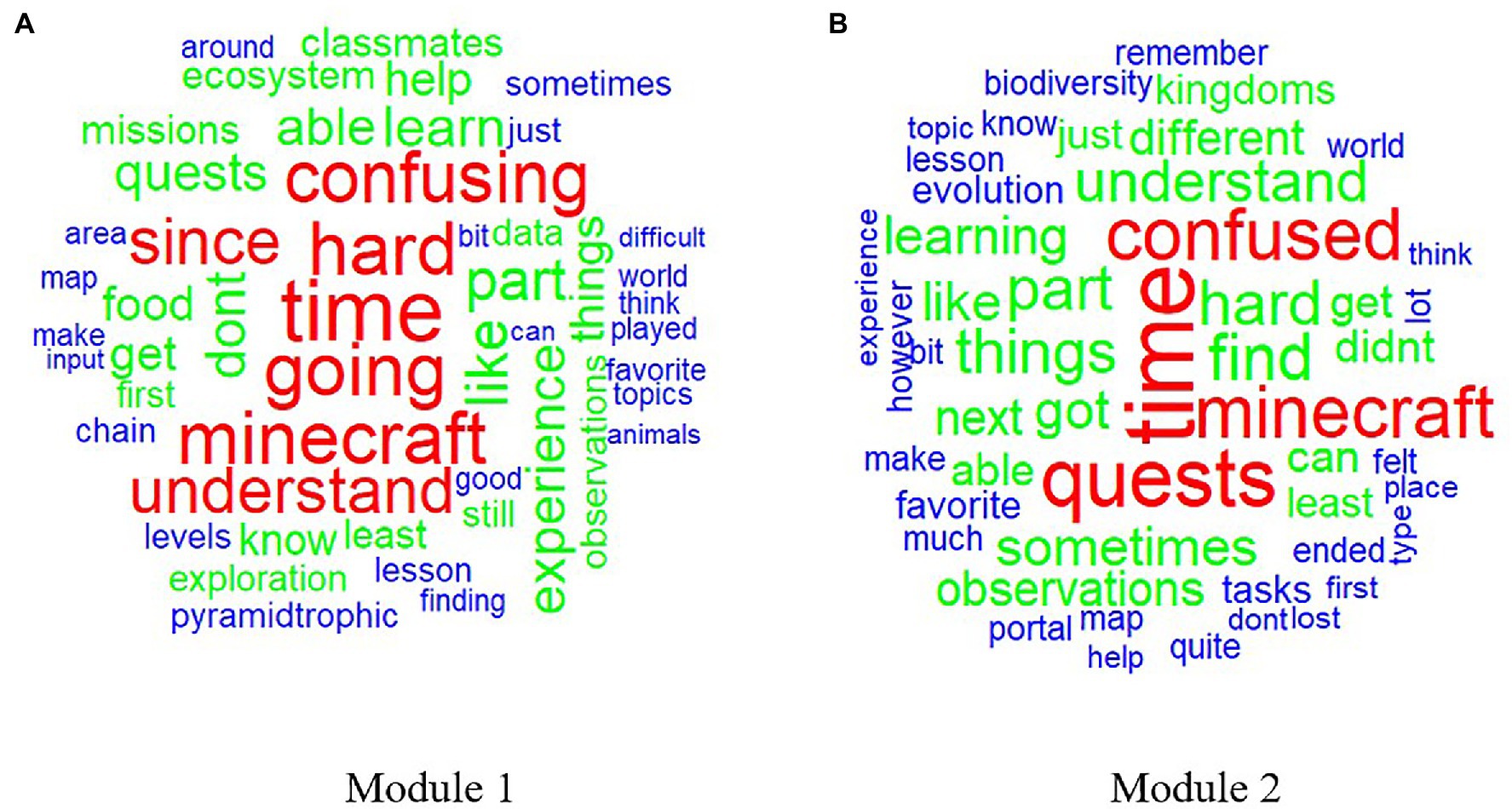
Figure 10. Frequencies of Dominant Words on the Least Favorite Attributes. (A) Module 1, (B) Module 2.
The top five dominant words for the responses on the least favorite attributes of Module 2 (Figure 10B) are time, quests, Minecraft, confused, and find. These words relate to the experience that the students had while doing the tasks integrated into the module using WHIMC. Students commented about experiencing a hard time completing the quests, finding the NPCs, and being confused about where to go next to complete the quests. These comments relate to the task and game attributes of the module.
Why did student preferences differ from Module 1 to Module 2? We offer some speculation: The learning objectives of Module 1 were simple (see Figure 2), and students only had to explore the biodome to perform the learning tasks and get the answers to the out-of-game assessments. This means that Module 1 tended to be easy, which may account for why high-performers liked all the module attributes and low-performers liked the topic and task attributes. Low-performers did not express liking the game attribute, a sentiment echoed by their GEQ responses, in which they had slightly higher ratings for Negative Affect and Tension dimensions compared to high-performers. Low-performers might have found the open-ended learning environment confusing. They might not have had a high-level understanding of their location, leading them to wander without purpose (Esclamado and Rodrigo, 2022a).
For Module 2, students had to explore three WHIMC worlds (Tilted Earth, No Moon, Colder Sun). They had to make observations to infer the possible adaptations of organisms and explain how these adaptations could lead to species diversity and survival. Module 2 was harder and more open-ended than Module 1. This might explain why many high performers expressed not liking the task module attribute.
4. Discussion
Learners often find STEM difficult because it requires complex thinking, repeated practice, and self-discipline. Hence, educators are thinking of innovative ways to provide an engaging learning environment that keeps students interested and enthusiastic about STEM subjects. Minecraft is one of the innovative approaches that has been adopted in science education (Pusey and Pusey, 2015; Nkadimeng and Ankiewicz, 2022). Thus, the purpose of this study is to continue to promote the use of WHIMC-based modules as a learning tool to cultivate the STEM interests of Filipino middle school students.
Our first research question is to determine the effect of using WHIMC on the STEM interests of students. The result of the analysis of the aggregated SIQ ratings before and after using the WHIMC-based modules revealed only a minimal effect on the STEM interests of the students. This implies that the implementation of the WHIMC-based modules in a Philippine middle school did not reveal a significant impact on the students’ STEM interests based on their SIQ ratings. This finding supports the result of the analysis of the STEM interest of primary school learners in the Philippines (Casano and Rodrigo, 2022b). But the result of this study is promising since there is still an increase in the SIQ ratings of students after learning two ecology topics with WHIMC. Further, there is a significant increase in the Choice Actions construct, which suggests that the students appreciate the importance of motivation to study hard and get good grades if they want to pursue STEM-related careers. Moreover, the significant increase in the Self-efficacy ratings of low-performers might suggest that they gained some confidence in their ability to understand science concepts after using WHIMC. This result is aligned with Nkadimeng and Ankiewicz (2022) that using MinecraftEdu helped students gain a more concrete understanding of abstract topics. High-performers’ increased level of agreement in the Interests construct may be related to how much they enjoyed and persisted in completing the assigned tasks from the WHIMC-based modules. This result corroborates the findings that using a digital game in teaching may be successful in fostering STEM interest (Bonner and Dorneich, 2016; Saricam and Yildirim, 2021; Ishak et al., 2022). Development of additional WHIMC-based modules focused on ecology topics might be needed to conduct a further evaluation to confirm or contrast the result of this study. This endeavor will be challenging since successful module design and implementation is time-consuming and requires technical, pedagogical, and content knowledge.
We also wanted to find out if there is a difference in the game experience between the high-performers and low-performers. The analysis of the overall GEQ ratings revealed no statistically significant difference between the game experience of high- and low-performers. We can infer that the overall game experience with WHIMC was the same for high and low performers, which confirms the finding of Casano and Rodrigo (2022b). Statistical tests were also conducted for each GEQ dimension to check if there were dimensions that would reveal statistical significance between the high- and low-performers. Among the 7 GEQ dimensions, only the Immersion dimension showed a statistically significant difference between the groups. Although they have the same level of agreement for Negative and Positive Affect, Challenge, Competence, Flow, and Tension, high-performers have significantly higher GEQ ratings on the Immersion dimension. With this finding, we can infer that high-performers had a more positive, engaging, and enjoyable learning experience with WHIMC than the low-performers. These results support the findings of other studies that game-based learning could increase learning achievement (Hwang et al., 2012; Chu and Chang, 2014), engagement (Lester et al., 2014; Alonso-Fernandez et al., 2019; Gadbury and Lane, 2022), desire to learn (Gadbury & Lane), and enjoyment (Alawajee, 2021).
Lastly, we wanted to determine the relationship between the module attributes and student performance. The results of the thematic analysis of the open-ended questions revealed that the WHIMC-based module attributes could affect the student performance and interests of students in learning science concepts. The findings on the favorite module attributes suggest that students perform better in the out-of-game assessments when they like all the module attributes. This implies that students must be engaged in the game and learning task aside from being interested in the learning topic to have better assessment scores. This finding corroborates the result of the analysis of GEQ ratings, where high-performers have higher ratings for immersion and flow dimensions after using WHIMC. The dominant words and themes of responses relate to the integration of WHIMC into the modules that allow students to learn and have a fun and enjoyable learning experience. The comments about the students’ ability to understand the topics and the fun experience they had with the WHIMC-based modules could inform us about the suitability of using WHIMC as a learning tool in science education.
The findings on the thematic analysis of the least favorite module attribute revealed that the game and learning task attributes are the least favorite for Module 1. This result might be because students encountered technical difficulties while playing and experienced a hard time completing the quests or tasks assigned in the module. This result is aligned with the findings of Casano and Rodrigo (2022b) that low performers experienced difficulty in learning because of technical bugs and the learning tasks made it difficult for high performers to learn. For Module 2, most comments come from the high-performers who identified the learning task module attribute as their least favorite. This finding might be because of the many tasks assigned in this module, which require more time to complete and more observations to be recorded while playing the game. High-performers acknowledged the difficulty of the learning task but were still motivated to complete them. Students who did not cite any least favorite module attribute emphasized how fun learning was and how well they understood the lessons. The negative comments about the game and task attributes should be addressed in the future development of WHIMC-based modules to enhance the student learning experience and interests in STEM. Future module developments should consider the appropriate task completion duration since students can complete the tasks at different times. To alleviate the technical difficulties encountered while using WHIMC, partner teachers should organize more time for students to develop familiarity with the software so that they will be able to use the game’s function effectively and efficiently.
The results of the thematic analyses on the favorite and least favorite module attribute are consistent with the findings about game-based learning. Researchers found that it improves student motivation (Hwang et al., 2012; Chu and Chang, 2014; Ennis, 2018; Leong et al., 2018; Hussein et al., 2019; Shang et al., 2019), encourages the player to learn (Iliya and Jabbar, 2015; Gadbury and Lane, 2022), helps in easy understanding of topics (Nkadimeng and Ankiewicz, 2022), and provides enjoyable coursework (Pusey and Pusey, 2015; Alawajee, 2021). With these findings, this research could contribute to the evidences of the impact of using game-based learning in teaching science concepts.
This research contributes to the literature in a number of ways. It suggests that an open-ended environment can be used to foster STEM interest, which corroborates previous findings on the use of Minecraft during summer camps (Yi et al., 2020, 2021; Lane et al., 2022). It collects and analyzes game-based data from the Philippines, a population that is underrepresented in the literature. It also contributes to the conversation about how and when games should be used with instruction. The study shows that Minecraft can be fun and engaging but just because it is fun and engaging does not guarantee that it will lead to increased interest in larger domains such as STEM. The study also shows that open-ended learning environments coupled with tasks that demand exploration, observation, and higher-ordered thinking are demanding even on high-performers. Low-performing students may require more scaffolding and guidance. Finally, the integration of educational games like Minecraft in classes requires lengthy lesson planning and technical preparation. Educators therefore have to curate the games well and monitor their outcomes in order to ascertain whether their use is truly worth the investment.
5. Limitations to the study
The work presented in this paper has some limitations. First, the analysis is only limited to the 2 WHIMC-based modules developed by partner teachers in a Philippine middle school. Thus, the findings from this initial study cannot be generalized because of the small number of topics used to determine the effect of using the modules on the STEM interests of students and game experience. We plan to have more partner teachers that will develop additional WHIMC-based modules and deploy these to other middle schools in the Philippines to see whether we can replicate the findings of this initial study.
During the module implementation, in-game data were also collected along with the SIQ, GEQ, and open-ended questions. So far, we have not yet analyzed the in-game data consisting of students’ observations, use of science tools, and map explorations. In future work, we plan to analyze these in-game data to understand the in-game behaviors of students while interacting with the WHIMC worlds and their relationship to student performance and STEM interests.
Data availability statement
The raw data supporting the conclusions of this article will be made available by the authors, without undue reservation.
Ethics statement
The studies involving human participants were reviewed and approved by University Research Ethics Committee of the Ateneo de Manila University. Written informed consent to participate in this study was provided by the participants’ legal guardian/next of kin.
Author contributions
CT: writing, data analysis, coding, statistical analysis, and editing. MR: writing, editing, reviewing, and supervision. JC: writing and review. All authors contributed to the article and approved the submitted version.
Funding
Ateneo de Manila University and the Department of Science and Technology for the grant entitled, “Nurturing Interest in STEM among Filipino learners using Minecraft.”
Acknowledgments
The authors thank H Chad Lane and Jeff Ginger for their enthusiastic collaboration, Dominique Maire Antoinette Manahan, Maricel Esclamado, Mikael William Fuentes, and Ma. Rosario Madjos for their support, our partner teachers and all participating students, Andhee Jacobe and Bobby Roaring for coding the module attributes, the Ateneo Laboratory for the Learning Sciences, and the Ateneo de Manila University. The authors thank our funding agency, the Department of Science and Technology for the grant entitled, “Nurturing Interest in STEM among Filipino learners using Minecraft,” and our monitoring agency, the Philippine Council for Industry, Energy, and Emerging Technology Research and Development.
Conflict of interest
The authors declare that the research was conducted in the absence of any commercial or financial relationships that could be construed as a potential conflict of interest.
Publisher’s note
All claims expressed in this article are solely those of the authors and do not necessarily represent those of their affiliated organizations, or those of the publisher, the editors and the reviewers. Any product that may be evaluated in this article, or claim that may be made by its manufacturer, is not guaranteed or endorsed by the publisher.
References
Alawajee, O. (2021). Minecraft in education benefits learning and social engagement. Int. J. Game-Based Learn. 11, 19–56. doi: 10.4018/IJGBL.2021100102
Alonso-Fernandez, C., Calvo-Morata, A., Freire, M., Martinez-Ortiz, I., and Fernandez-Majón, B. (2019). Applications of data science to game learning analytics data: a systematic literature review. Comput. Educ. 141, 103612–103619. doi: 10.1016/j.compedu.2019.103612
Bertozzi, E. (2014). Using Games to Teach, Practice and Encourage Interest in STEM Subjects. Learning, Education and Games. ETC Press, Pittsburgh, PA, USA, 23–36.
Bitner, J. (2021). What is Minecraft?. Digital Trends. Available at: https://www.digitaltrends.com/gaming/what-is-minecraft/.
Bonner, D., and Dorneich, M. (2016). Developing game-based learning requirements to increase female middle school students interest in computer science. In Proceedings of the Human Factors and Ergonomics Society Annual Meeting (Vol. 60, No., pp. 380–384). Sage CA: Los Angeles, CA: SAGE Publications.
Casano, J. D. L., and Rodrigo, M. M. T. (2022a). “A comparative assessment of US and PH learner traversals and in-game observations within Minecraft,” in Artificial Intelligence in Education. Posters and Late Breaking Results, Workshops and Tutorials, Industry and Innovation Tracks, Practitioners’ and Doctoral Consortium. AIED 2022. eds. M. M. Rodrigo, N. Matsuda, A. I. Cristea, and V. Dimitrova, Lecture Notes in Computer Science, vol. 13356 (Cham: Springer).
Casano, J. D. L., and Rodrigo, M. M. T. (2022b). “An Analysis of Filipino Primary School Learners’ Game Experience and STEM Interest within Minecraft,’’ in 30th International Conference on Computers in Education (ICCE 2022). eds. S. Iyer, J-L. Shih, W. Chen, and M. N. MD Khambari (Taiwan: Asia-Pacific Society for Computers in Education).
Chu, H., and Chang, S. (2014). Developing an educational computer game for migratory bird identification based on a two-tier test approach. Educ. Technol. Res. Dev. 62, 147–161. doi: 10.1007/s11423-013-9323-4
Ekaputra, G., Lim, C., and Eng, K. I. (2013). Minecraft: A Aame as an Education and Scientific Learning Tool. Bali, Indonesia: ISICO.
Ennis, L. (2018). Game-Based Learning: An Instructional Tool. Available at: https://dr.lib.iastate.edu/handle/20.500.12876/17144
Esclamado, M. A., and Rodrigo, M. M. T. (2022a). “Are all who wander lost? An exploratory analysis of learner traversals of Minecraft worlds” in Artificial Intelligence in Education. Posters and Late Breaking Results, Workshops and Tutorials, Industry and Innovation Tracks, Practitioners’ and Doctoral Consortium. AIED 2022. eds. M. M. Rodrigo, N. Matsuda, A. I. Cristea, and V. Dimitrova, Lecture Notes in Computer Science, vol. 13356 (Cham: Springer)
Esclamado, M. A., and Rodrigo, M. M. T. (2022b). “Achievement, behaviors, and STEM interest of frustrated and bored learners using Minecraft,” in 30th International Conference on Computers in Education (ICCE 2022). eds. S. Iyer, J-L. Shih, W. Chen, and M. N. M. D. Khambari (Taiwan: Asia-Pacific Society for Computers in Education).
Gadbury, M., and Lane, H. C. (2022). “Mining for STEM interest behaviors in Minecraft,” in Artificial Intelligence in Education. Posters and Late Breaking Results, Workshops and Tutorials, Industry and Innovation Tracks, Practitioners’ and Doctoral Consortium. AIED 2022. eds. M. M. Rodrigo, N. Matsuda, A. I. Cristea, and V. Dimitrova, Lecture Notes in Computer Science, vol. 13356 (Cham: Springer). doi: 10.1007/978-3-031-11647-6_42
Gao, F., Li, L., and Sun, Y. (2020). A systematic review of mobile game-based learning in STEM education. Educ. Technol. Res. Dev. 68, 1791–1827. doi: 10.1007/s11423-020-09787-0
Hussein, M. H., Ow, S. H., Cheong, L. S., Thong, M. -K., and Ale Ebrahim, N. (2019). Effects of digital game-based learning on elementary science learning: a systematic review. IEEE Access 7, 62465–62478. doi: 10.1109/ACCESS.2019.2916324
Hwang, G.-J., Sung, H. -Y., Hung, C. -M., Haung, I., and Tsai, C. -C. (2012). Development of a personalized educational computer game based on students’ learning styles. Educ. Technol. Res. Develop. 60, 623–638. doi: 10.1007/s11423-012-9241-x
IJsselsteijn, W. A., De Kort, Y. A., and Poels, K. (2013). The Game Experience Questionnaire. Technische Universiteit Eindhoven.
Iliya, A., and Jabbar, A. (2015). Gameplay engagement and learning in game-based learning: a systematic review. Rev. Educ. Res. 85, 740–779. doi: 10.3102/0034654315577210
Ishak, S. A., Din, R., Othman, N., Gabarre, S., and Hasran, U. A. (2022). Rethinking the ideology of using digital games to increase individual interest in STEM. Sustainability 14:4519. doi: 10.3390/su14084519
Johnson, D., Gardner, M. J., and Perry, R. (2018). Validation of two game experience scales: the player experience of need satisfaction (PENS) and game experience questionnaire (GEQ). Int. J. Hum. Comput. Stud. 118, 38–46. doi: 10.1016/j.ijhcs.2018.05.003
Lane, H. C., Gadbury, M., Ginger, J., Yi, S., Comins, N., Henhapl, J., et al. (2022). Triggering STEM interest with Minecraft in a hybrid summer camp. Technol. Mind Behav. 3, 1–18. doi: 10.1037/tmb0000077
Lent, R. W., and Brown, S. D. (2008). Social cognitive career theory and subjective well-being in the context of work. J. Career Assess. 16, 6–21. doi: 10.1177/1069072707305769
Leong, P., Eichelberger, A., and Asselstine, S. (2018). Digital building blocks for learning: motivating and engaging students through Minecraft game-based learning. Int. J. Educ. Media Technol. 12, 35–41. Available at: https://jaems.jp/contents/icomej/vol12-2/05_Leong_Eichelberger.pdf
Lester, J. C., Spires, H. A., Nietfeld, J. L., Minogue, J., Mott, B. W., and Lobene, E. V. (2014). Designing game-based learning environments for elementary science education: a narrative-centered learning perspective. Inf. Sci. 264, 4–18. doi: 10.1016/j.ins.2013.09.005
Manahan, D. M. A. B., and Rodrigo, M. M. T. (2022). “Support structures and activities 1908 for teachers preparing for game-based learning. 10th workshop on technology-enhanced 1909 STEM education (TeSTEM,” in 30th International Conference on 1910 Computers in Education (ICCE 2022). eds. S. Iyer, J-L. Shih, W. Chen and M. N. M. D. Khambari (Taiwan: Asia-Pacific Society for Computers in Education).
Mohtar, L. E., Halim, L., Abd Rahman, N., Maat, S. M., Iksan, Z. H., and Osman, K. (2019). A model of interest in stem careers among secondary school students. J. Balt. Sci. Educ. 18, 404–416. doi: 10.33225/jbse/19.18.404
Nkadimeng, M., and Ankiewicz, P. (2022). The affordances of Minecraft education as a game-based learning tool for atomic structure in junior high school science education. J. Sci. Educ. Technol. 31, 605–620. doi: 10.1007/s10956-022-09981-0
Pusey, M., and Pusey, G. (2015). Using Minecraft in the science classroom. Int. J. Innov. Sci. Math. Educ. 23, 22–34. Available at: https://openjournals.library.sydney.edu.au/CAL/article/view/10331
Roller, S. A., Lampley, S. A., Dillihunt, M. L., Benfield, M. P., and Turner, M. W. (2018). “Student attitudes toward STEM: a revised instrument of social cognitive career theory constructs (fundamental),” In 2018 ASEE Annual Conference & Exposition. (American Society for Engineering Education).
Saricam, U., and Yildirim, M. (2021). The effects of digital game-based STEM activities on Students' interests in STEM fields and scientific creativity: Minecraft case. Int. J. Technol Educ. Sci. 5, 166–192. doi: 10.46328/ijtes.136
Shang, J., Ma, S., Hu, R., Pei, L., and Zhang, L. (2019). “Game-based learning in future school” in Shaping Future Schools with Digital Technology. Perspectives on Rethinking and Reforming Education. eds. S. Yu, H. Niemi, and J. Mason (Singapore: Springer), 125–146.
Wang, L. H., Chen, B., Hwang, G. J., Guan, J. Q., and Wang, Y. Q. (2022). Effects of digital game-based STEM education on students’ learning achievement: a meta-analysis. Int. J. STEM Educ. 9, 1–13. doi: 10.1186/s40594-022-00344-0
What-If Hypothetical Implementations in Minecraft (WHIMC) (n.d.). What-If Hypothetical Implementations in Minecraft (WHIMC). Available at: https://whimcproject.web.illinois.edu/
Yi, S., Gadbury, M., and Lane, H. C. (2020). “Coding and analyzing scientific observations from middle school students in Minecraft,” in The Interdisciplinarity of the Learning Sciences, 14th International Conference of the Learning Sciences (ICLS) 2020 Vol. 3. eds. M. Gresalfi and I. S. Horn (Virtual Nashville, TN, USA: International Society of the Learning Sciences), 1787–1788.
Yi, S., Gadbury, M., and Lane, H. C. (2021). “Identifying and coding STEM interest triggers in a summer camp,” in Proceedings of the 15th International Conference of the Learning Sciences – ICLS 2021. eds. E. de Vries, Y. Hod, and J. Ahn (Bochum, Germany: International Society of the Learning Sciences), 915–916.
Yi, S., and Lane, H. C. (2019). What-if Hypothetical Implementations in Minecraft (WHIMC). Available at: https://www.researchgate.net/publication/339997313_What-if_hypothetical_implementations_in_Minecraft_WHIMC
Keywords: Minecraft, WHIMC world, STEM interest, digital game-based learning, educational games
Citation: Tablatin CLS, Casano JDL and Rodrigo MMT (2023) Using Minecraft to cultivate student interest in STEM. Front. Educ. 8:1127984. doi: 10.3389/feduc.2023.1127984
Edited by:
Wang-Kin Chiu, The Hong Kong Polytechnic University, ChinaReviewed by:
Vanessa Camilleri, University of Malta, MaltaMawardi – Mawardi, Padang State University, Indonesia
Copyright © 2023 Tablatin, Casano and Rodrigo. This is an open-access article distributed under the terms of the Creative Commons Attribution License (CC BY). The use, distribution or reproduction in other forums is permitted, provided the original author(s) and the copyright owner(s) are credited and that the original publication in this journal is cited, in accordance with accepted academic practice. No use, distribution or reproduction is permitted which does not comply with these terms.
*Correspondence: Christine Lourrine S. Tablatin, dGFibGF0aW5jaHJpc3RpbmVAZ21haWwuY29t
 Christine Lourrine S. Tablatin
Christine Lourrine S. Tablatin Jonathan D. L. Casano
Jonathan D. L. Casano Maria Mercedes T. Rodrigo
Maria Mercedes T. Rodrigo